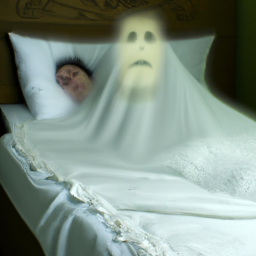Throughout most of my life, I have been dealing with nightmares, so I understand firsthand their unsettling and exhausting impact. Waking up in the middle of the night with a racing heart and a mind filled with scary images and scenarios is not only unpleasant but can also throw off our daily schedules.
That’s why I’ve done some research on how to stop bad dreams, and I’m excited to share my findings with you.
In this article, we’ll explore various ways to prevent nightmares and get a good night’s sleep. From understanding the science behind dreams to identifying your triggers and creating a calming bedtime routine, we’ll cover everything you need to know about stopping those pesky bad dreams.
Whether you’re plagued by occasional nightmares or chronic ones, these tips will help you take control of your subconscious mind and enjoy peaceful nights of restful sleep.
Key Takeaways
- Identifying triggers and avoiding stressors can help prevent bad dreams.
- Creating a calming bedtime routine and reducing screen time before bed can improve sleep quality and reduce nightmares.
- Relaxation techniques such as deep breathing, meditation, and essential oils can alleviate stress and promote relaxation.
- Seeking professional help through therapy or medication may be necessary if bad dreams persist and disrupt daily life.
Understand the Science Behind Dreams
Understanding the science behind dreams can provide valuable insight into why we have bad dreams and how to prevent them. Dream interpretation has been studied for centuries, with different cultures having their own beliefs about what they mean. However, modern science has discovered that dreams occur during Rapid Eye Movement (REM) sleep patterns.
During REM sleep, the brain is highly active, but the body is paralyzed to prevent acting out dreams physically. This state allows our brains to process and consolidate memories from the day before. Dreams are thought to be a way for our minds to make sense of these memories by creating stories or scenarios in which they can fit.
Bad dreams often occur when our minds are overwhelmed with stress or anxiety, leading to negative dream content. By understanding this science, we can begin to identify patterns in our dream content and work on reducing stressors in our waking lives that may contribute to bad dreams.
Identifying your triggers is a key step in preventing bad dreams.
Identify Your Triggers
As you navigate through the maze of your subconscious mind, be mindful of the shadowy corners that may trigger unwelcome visitors in your slumber. Identifying triggers is an essential step in stopping bad dreams. Here are some helpful tips to identify common triggers and avoid them.
Firstly, keep a dream journal beside your bed and record any details about your dreams as soon as you wake up. By identifying recurring themes or patterns, you can pinpoint what triggers your bad dreams.
Secondly, pay attention to what you eat before bedtime. Spicy foods and heavy meals can disrupt sleep and lead to vivid nightmares.
Lastly, try to limit exposure to stressful situations before bedtime. Watching violent movies or engaging in intense conversations can cause anxiety that carries over into your sleep.
By understanding what triggers your bad dreams, you can take steps towards eliminating them from your subconscious mind.
In the next section, we’ll discuss how creating a calming bedtime routine can further improve the quality of your sleep.
Create a Calming Bedtime Routine
I’ve found that creating a calming bedtime routine has helped me to sleep better and wake up feeling more refreshed.
One key component of my routine is reducing my screen time before bed, as the blue light emitted from electronic devices can disrupt our natural sleep cycle.
I also practice relaxation techniques such as deep breathing or meditation, and make sure to create a comfortable sleeping environment with a supportive mattress and pillows.
Research shows that these habits can promote better sleep quality and reduce the likelihood of experiencing bad dreams or nightmares.
Reduce Screen Time
Limiting screen time before bed can help mitigate the occurrence of negative dreams. When we use electronic devices such as phones, tablets, or computers, our brains become stimulated by the blue light emitted from these screens. This can delay our body’s natural production of melatonin, a hormone that regulates sleep and wake cycles. As a result, we may experience difficulty falling asleep or staying asleep throughout the night.
To reduce screen time before bed, consider engaging in alternative activities such as reading a book, listening to calming music, or practicing relaxation techniques. These screen-free activities can help prepare your mind and body for restful sleep. Additionally, reducing screen time has been linked to various benefits such as improved mental health and increased productivity during waking hours. By incorporating these habits into your bedtime routine, you’re ultimately setting yourself up for a better night’s sleep and fewer negative dreams.
Reducing screen time is just one way to promote peaceful slumber and prevent bad dreams. In addition to limiting technology usage before bed, it’s also helpful to practice relaxation techniques like deep breathing exercises or meditation. These practices can calm the mind and alleviate stressors that may contribute to nightmares. By adopting healthy habits like these on a consistent basis, you’ll be able to improve your overall quality of sleep and enjoy more pleasant dreams as a result.
Practice Relaxation Techniques
You can experience an unparalleled sense of relaxation and tranquility by incorporating simple breathing exercises and meditation into your bedtime routine. Deep breathing is a powerful technique that helps to calm the mind and reduce anxiety levels. You can try inhaling slowly through your nose, holding your breath for a few seconds, then exhaling slowly through your mouth. Repeat this process several times until you feel relaxed.
Meditation techniques are also effective in reducing bad dreams. You can start by focusing on a positive image or thought, such as imagining yourself in a peaceful place or repeating a calming mantra. It’s important to be patient with yourself when practicing these techniques; it may take some time before you notice their benefits.
Additionally, creating a comfortable sleeping environment can further enhance the effectiveness of these relaxation techniques.
Create a Comfortable Sleeping Environment
Now that we’ve talked about relaxation techniques that can help you calm down before bed, let’s move on to creating a comfortable sleeping environment.
The way your bedroom is set up and the scents you surround yourself with can greatly affect the quality of your sleep and dreams.
Firstly, take a look at your bedroom layout. Is it cluttered? Is there too much stimulation around you?
Your bedroom should be a place of rest and relaxation, so try to keep it as simple and peaceful as possible. This might mean decluttering or rearranging some furniture to create more open space.
Additionally, consider investing in blackout curtains or shades if light pollution is an issue in your area.
Another factor to consider is scent. Certain smells can be incredibly soothing and promote a better night’s sleep. Try using essential oils like lavender, chamomile, or ylang-ylang in a diffuser or pillow spray before bedtime.
These scents have been shown to reduce stress levels and promote relaxation.
As you begin to feel more relaxed during this process, it becomes easier for your mind to drift off into peaceful sleep without encountering bad dreams.
Speaking of which, one effective way of dealing with bad dreams is keeping track of them through keeping a dream journal…
Keep a Dream Journal
One easy way to help prevent bad dreams is by starting a dream journal where you can record and reflect on your dreams each morning. Reflective writing allows you to explore the emotions and thoughts associated with your dreams, helping you identify patterns or triggers that may be causing bad dreams. Interpretation exercises, such as analyzing symbols or events in your dreams, can also provide insight into your subconscious mind.
To get started with a dream journal, keep a notebook and pen by your bed so you can write down any dreams as soon as you wake up. Try to include as much detail as possible, including people, places, and emotions experienced during the dream. Once you have recorded several dreams over time, take some time to review them and look for patterns or common themes. This reflective process can help bring awareness to any underlying issues that may be contributing to bad dreams.
Incorporating imagery rehearsal therapy (IRT) into your dream journaling practice can further enhance its effectiveness in preventing bad dreams. IRT involves imagining yourself in a previous troublesome dream but changing it to end in a positive outcome. By visualizing this new scenario repeatedly before bed, it trains the brain to create more positive outcomes in future dreams. Using this technique alongside reflection and interpretation exercises from writing in your dream journal can be an effective way of dealing with nightmares and promoting peaceful sleep.
Use Imagery Rehearsal Therapy
I highly recommend using imagery rehearsal therapy to stop bad dreams. This therapy involves visualization techniques, role-playing, and positive reinforcement.
By visualizing a different outcome for your bad dream, you can train your brain to respond differently in the future.
Adjust the paragraph structure in the input to logically group complete sentences on their own lines, with a double new line after. Use contractions.
Visualization Techniques
Picture peaceful places to prevent disturbing dreams. This is the essence of creative visualization, a technique that involves imagining yourself in serene environments to promote relaxation and reduce anxiety.
Guided meditation is one way to achieve this state of mind, where a narrator or script provides cues for visualizing calming scenes. Incorporating visualization techniques into your bedtime routine can help you conquer bad dreams by creating positive associations with sleep.
By focusing on pleasant images, you can train your mind to shift away from negative thoughts and emotions that may trigger nightmares. But creative visualization isn’t just about escaping unpleasant experiences it’s also an opportunity to cultivate compassion and gratitude towards yourself and others.
When we picture ourselves in a nurturing environment, we are reminding ourselves of our innate capacity for self-care, which can translate into better decision-making and relationships with those around us. So why not give yourself the gift of a peaceful night’s rest through the power of visualization?
By practicing creative visualization before bed, you can prepare yourself for role-playing scenarios that might arise during your waking hours. Just as picturing tranquil landscapes can soothe your subconscious mind, envisioning successful outcomes in challenging situations can empower you to face them head-on with confidence and resilience.
Whether it’s rehearsing a difficult conversation or preparing for a big presentation at work, visualizing positive results allows you to tap into your inner resources and trust in your abilities. So don’t let bad dreams hold you back use visualization techniques to create a brighter future both in dreamland and beyond!
Role-Playing
Visualization techniques are an effective way to stop bad dreams, but there are other methods that can be used. One such method is role-playing. Role-playing involves acting out scenarios that may trigger bad dreams in a safe and controlled environment. This technique can help individuals better understand their fears and anxieties and lead to a reduction in the frequency of bad dreams.
Role playing benefits include the ability to confront fears in a controlled environment, which can lead to reduced anxiety levels when encountering similar situations in real life. There are many role playing techniques that can be utilized, including enlisting the help of friends or family members to act out scenarios, writing scripts for specific situations, or even using virtual reality technology. It is important for individuals to find the technique that works best for them and their unique situation.
Transition: By utilizing role-playing techniques, individuals have the ability to confront their fears and anxieties head-on, leading to reduced frequency of bad dreams. However, positive reinforcement can also play a crucial role in stopping bad dreams altogether.
Positive Reinforcement
Positive reinforcement is a powerful tool that can help individuals replace negative thought patterns with positive ones, leading to more peaceful and restful sleep. By implementing a rewards system and providing positive feedback, individuals can train their brains to focus on positive thoughts and emotions, which can ultimately lead to a decrease in bad dreams.
Here are some ways to incorporate positive reinforcement into your bedtime routine:
- Keep a dream journal and reward yourself for writing down your dreams each morning.
- Use affirmations before bed, such as "I’m safe and protected while I sleep."
- Practice visualization techniques of happy scenarios before drifting off to sleep.
- Give yourself praise for any progress made towards decreasing the frequency of bad dreams.
By consistently using these techniques, you may find that your mind becomes better equipped at focusing on positive thoughts during sleep. This sets the stage for practicing lucid dreaming, an advanced technique where you become aware that you’re dreaming and gain control over the events happening in your dreams.
Practice Lucid Dreaming
Listen up, if you want to stop those pesky nightmares, you need to start practicing lucid dreaming. Lucid dreaming is when you become aware that you’re dreaming and can take control of the dream. This means that you can change the outcome of the dream and turn it into something positive.
There are many benefits of lucid dreaming. Not only does it allow you to stop bad dreams, but it also helps with creativity, problem-solving skills, and reducing anxiety.
To achieve a lucid dream, there are tips you can follow such as reality checks throughout the day, keeping a dream journal, and setting intentions before going to sleep.
Practicing lucid dreaming takes time and effort but is worth it in the end. It allows for a better night’s sleep and reduces stress levels due to positive outcomes in dreams.
However, if lucid dreaming doesn’t work for some individuals or they feel like they need further assistance with stopping bad dreams, considering therapy or counseling may be beneficial. A therapist can help address underlying issues causing negative dreams and provide techniques for coping with them effectively.
Consider Therapy or Counseling
If you find yourself struggling to control your nightmares, it may be worth considering therapy or counseling to address underlying issues and develop effective coping techniques. Seeing a therapist can provide numerous benefits for individuals who experience bad dreams on a regular basis. One of the main advantages is that it allows people to explore their subconscious mind in a safe and controlled environment. Therapists use various types of counseling approaches to help clients connect with their emotions, thoughts, and behaviors related to their nightmares.
Some common types of counseling approaches used in addressing nightmares include cognitive-behavioral therapy (CBT), exposure therapy, and eye movement desensitization and reprocessing (EMDR). CBT focuses on changing negative thought patterns that contribute to anxiety or fear associated with bad dreams. Exposure therapy helps individuals confront their fears by gradually exposing them to situations or stimuli that trigger their nightmares. EMDR involves guided eye movements while recalling traumatic events associated with the nightmare.
Overall, seeking therapy or counseling can be an effective solution for those experiencing recurrent bad dreams. It provides a safe space for individuals to explore the root causes of their nightmares while also developing coping mechanisms tailored specifically for them. With this support, they can learn how to manage their nightmares better and improve overall mental health and wellness.
As we move forward into exploring different ways of stopping bad dreams, let’s take a look at how aromatherapy can play an essential role in promoting relaxation and calmness before bedtime without relying on medication or other chemical substances.
Use Aromatherapy
To create a relaxing atmosphere before bedtime, I highly recommend using aromatherapy with essential oils like lavender or chamomile. These scents have been shown to soothe the mind and promote restful sleep.
Aromatherapy diffusers are a great way to distribute the scent throughout your bedroom, creating a calming environment that can help you fall asleep more easily. In addition to promoting relaxation and sleep, certain essential oils also have therapeutic properties that can alleviate anxiety and stress.
For example, bergamot oil has been shown to reduce cortisol levels in the body, which is known as the stress hormone. By using aromatherapy regularly as part of your nighttime routine, you may find that you wake up feeling more refreshed and less anxious in the morning.
While aromatherapy is not a cure-all for bad dreams or other sleep disturbances, it can be an effective tool for improving your overall sleep quality. In combination with healthy habits like regular exercise and avoiding caffeine before bed, incorporating aromatherapy into your bedtime routine may help you achieve deeper, more restful sleep on a consistent basis.
Exercise Regularly
Regular exercise is essential for improving your sleep quality and getting a good night’s rest. Not only does it help reduce stress levels, but it also promotes the release of endorphins that can boost your mood and energy levels throughout the day.
There are various types of exercises that you can engage in to improve your sleep, including cardio workouts like running or cycling, strength training exercises such as weightlifting or yoga, and even low-impact activities like swimming or walking.
The benefits of regular exercise extend beyond just improving your sleep quality. It can also help prevent chronic illnesses such as heart disease, diabetes, and obesity. Additionally, it can boost your immune system and increase cognitive function, allowing you to be more productive during the day. To reap these benefits, aim for at least 30 minutes of moderate-intensity exercise every day.
While regular exercise is an effective way to improve your sleep quality and reduce bad dreams, seeking professional help may be necessary if the problem persists. A doctor or therapist can provide additional guidance on how to stop bad dreams and address any underlying issues that may be contributing to them. Don’t hesitate to seek professional assistance if you feel that your bad dreams are affecting your daily life.
Seek Professional Help
You may need to consider seeking professional help for your recurring nightmares if they continue to disrupt your daily life and well-being. Many people experience occasional bad dreams, but when they become chronic, it can be a sign of an underlying issue that needs to be addressed.
Therapy can be an effective solution for managing these distressing dreams. There are many benefits of therapy for those struggling with bad dreams. A therapist can help you identify the root cause of your nightmares and provide coping strategies to reduce their frequency and intensity. They can also teach you relaxation techniques such as deep breathing, meditation, and visualization exercises that promote better sleep hygiene.
When considering medication as a treatment option, it’s important to weigh the pros and cons carefully. While some medications may offer relief from nightmares in the short term, they often come with side effects such as drowsiness or cognitive impairment. It’s crucial to discuss all options with a qualified healthcare professional before making any decisions about medication.
If you’re unsure where to start looking for a therapist, ask your primary care physician or mental health provider for recommendations or search online directories like Psychology Today or GoodTherapy.org. Remember that seeking help is a brave step towards healing and improving your overall quality of life.
Frequently Asked Questions
How can I physically prevent myself from having bad dreams?
I’ve found that incorporating meditation techniques and adjusting my sleep environment has helped me sleep better. Creating a comfortable and calming space to rest in, combined with the relaxation benefits of meditation, can help prevent bad dreams from occurring.
Can certain foods or drinks affect the frequency of bad dreams?
While certain foods and drinks can affect sleep quality, there is limited research on their impact on dreams. However, avoiding heavy meals and alcohol before bed may reduce risk of nightmares.
Is it possible to completely stop having dreams altogether?
While it’s possible to reduce the frequency of dreaming, completely stopping them isn’t realistic. However, lucid dreaming and dream journaling can help manage their effects on your mental health, allowing for better sleep quality.
Are there any natural supplements or remedies that can help prevent bad dreams?
Herbal remedies such as valerian root, chamomile tea, and lavender can aid in reducing anxiety and promoting relaxation. Meditation techniques like mindfulness can also help calm the mind before bedtime, potentially leading to fewer bad dreams.
Can listening to specific types of music before bed help prevent bad dreams?
I’ve found that incorporating music therapy and relaxation techniques before bed can have a profound effect on the quality of my sleep. Certain types of music, such as classical or ambient, can create a calming atmosphere conducive to peaceful dreams.
Conclusion
In conclusion, bad dreams can be a distressing experience, but there are ways to prevent and stop them. By understanding the science behind dreams, identifying triggers, and creating a calming bedtime routine, you can reduce the likelihood of having bad dreams.
Keeping a dream journal, using imagery rehearsal therapy, considering therapy or counseling, using aromatherapy, exercising regularly, and seeking professional help if needed are also effective strategies.
One anticipated objection to these methods may be that they require too much effort or time. However, taking the time to implement these techniques is worth it in order to improve your overall well-being. Remember that good sleep is essential for mental and physical health.
By prioritizing your sleep hygiene and taking care of yourself before bedtime, you can wake up feeling refreshed in the morning. Finding what works best for you will take some trial and error, but with persistence and effort, anyone can overcome night terrors or nightmares.
By consistently utilizing these strategies over time, you should start seeing an improvement in not only your quality of sleep but also your mental state during waking hours as well.









